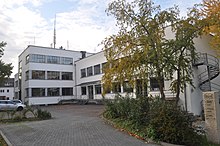Fissan

Fissan was the most successful manufacturer's brand of Deutsche Milchwerke AG in Zwingenberg on the Hessian Bergstrasse, where this company, founded in 1882, was at times the largest employer. The Fissan brand was introduced in the 1920s and is used today by the Unilever company .
Brand and company history
1882 Wormser pharmacists began Rudolf Pizzala with the production of antidepressants bio-based, initially on a small scale with about six employees. The chemist Arthur Sauer (1874–1946) joined in 1897 and took over the company in 1898. He specialized in milk preparations on the chemical basis of casein and called his company Deutsche Milchwerke Dr. A. Sauer . Expansion took place, among other things, through the establishment of branches - e.g. B. in Stockheim (Upper Hesse) .
After our own research into milk protein , a product range with powders , pastes , oils and soaps was developed under the Fissan brand from the mid-1920s , which became successful worldwide. Fissan is a word created from the Latin terms "fissura" and "sanare" and means something like "to heal a wound". On the basis of this success, the company became one of the most important employers on the Hessian Bergstrasse in the 1930s. In 1934 the company already had 160 workers and employees as well as 50 commercial employees, some of whom lived in a newly built factory complex.
After the occupation of Zwingenberg by the American troops on March 27, 1945, the factory facilities and parts of the factory settlement, as well as the Villa Sauer, were confiscated. The outsourced production was resumed on April 30, 1945. After expropriation and judicial proceedings, Arthur Sauer died on November 29, 1946 under unclear circumstances.
The new head was the chemist Veith, who led the company in the 1950s and 1960s. In 1969 Preussag took over two thirds of the shares, the remaining third was owned by the Kinzinger family. On March 1, 1970 Preussag also acquired the remaining shares. The Fissan plant was sold to the Darmstadt chemical company Merck , which continued the brand but closed the plant.
From the mid-1990s, the Fissan brand was used by Sara Lee Deutschland GmbH . In spring 2007, the brand was relaunched under the name Fissan Kids, and as a result, the Fissan Kids Princess Lillifee and Fissan Kids Felix product lines emerged from a cooperation with Coppenrath Verlag . In 2010 the Unilever Group took over the company and the brand.
Company building in Zwingenberg
The company building was built from 1934 in the New Building style based on a design by the architect Georg Fehleisen . In 1934/1935 the raised central wing and the south wing were built as the first component. Around 1940 the north wing was supplemented by the architect Richard Busching in the same design language . The building is a listed building and is now used by the Brain Biotech company .
Factory settlement in Zwingenberg
In 1933/1934 Georg Fehleisen (1893–1936) built a small factory settlement for workers and employees of Deutsche Milchwerke AG . The settlement consists of seven individual houses. Four houses with a square floor plan are arranged symmetrically. Above is the operations manager's villa and, at the same level, a little further north is the smaller villa of the deputy operations manager. The seventh building, a workers' house with a steep pitched roof, faces northwest.
In the time of National Socialism , the facility was named "Adolf Hitler Settlement" from Christmas 1933 with the highest approval. Today the houses are located on the Arthur-Sauer-Anlage named after the entrepreneur. The settlement is also a listed building.
literature
- Bernd Philipp Schröder: Georg Fehleisen and the end of the Bergstrasse architectural tradition, in: Geschichtsblätter Kreis Bergstrasse, 2003, pp. 245–287.
Web links
- Fissan on the Unilever website , accessed November 3, 2013
- The Fissan brand and its history at www.markenmuseum.de , accessed on November 3, 2013
- Chronology Fissan
Individual evidence
- ↑ a b Dieter Griesbach-Maisant (edit.): Monument topography Federal Republic of Germany , cultural monuments in Hesse, Bergstrasse district, Volume I, The cities of Bensheim, Heppenheim and Zwingenberg. Theiss, Stuttgart 2004, ISBN 3-8062-1905-2 , p. 50, p. 848-850.
- ↑ Operations building Darmstädter Straße 34/36 in the database cultural monuments in Hessen , accessed on November 3, 2013
- ^ Werksiedlung Arthur-Sauer-Anlage 3, 4, 5, 6, Stuckertstrasse 10, 18 in the database of cultural monuments in Hessen , accessed on November 3, 2013
Coordinates: 49 ° 43 ′ 39.9 " N , 8 ° 36 ′ 39.4" E

